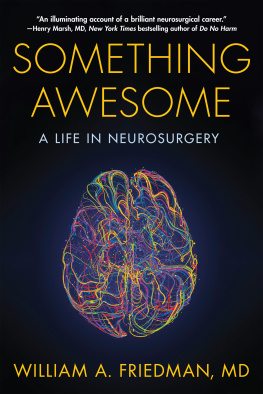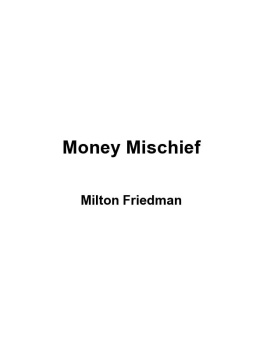
Contents


SOMETHING
AWESOME

Radius Book Group
A Division of Diversion Publishing Corp.
New York, NY
www.RadiusBookGroup.com
Copyright 2021 by William A. Friedman
Death Be Not Proud by John J. Gunther. Copyright 1949 by John Gunther. Copyright renewed 1976 by Jane Perry Gunther. Used by permission of HarperCollins Publishers.
Lonesome Town
Words and Music by Baker Knight
Copyright 1958 Matragun Music, Inc. and EMI Unart Catalog Inc.
Copyright Renewed
All Rights on behalf of Matragun Music, Inc. Administered by Sony/ATV Music Publishing LLC, 424 Church Street, Suite 1200, Nashville, TN 37219
International Copyright Secured All Rights Reserved
Reprinted by Permission of Hal Leonard LLC
All rights reserved, including the right to reproduce this book or portions thereof in any form whatsoever. No part of this publication may be reproduced or transmitted in any form or by any means, electronic or mechanical, including photocopying, recording, or any other information storage and retrieval, without the written permission of the author.
For more information, email .
First edition: February 2021
Trade Paperback ISBN: 978-1-63576-754-4
eBook ISBN: 978-1-63576-751-3
Library of Congress Control Number: 2020915557
Manufactured in the United States of America
10 9 8 7 6 5 4 3 2 1
Cover design by Charles Hames
Interior design by Neuwirth & Associates Inc.
Radius Book Group and the Radius Book Group colophon are registered trademarks of Radius Book Group, a Division of Diversion Publishing Corp.
CONTENTS |

|

I ts September 2020, and Im going to tell you a story. Its a story about how highly trained, devoted individuals from disparate backgrounds can come together and, because of their devotion to their patients, strive to produce a good outcome. It doesnt always work (see chapter 10), but if the team is good, the outcome is usually good.
Whats the most relaxing thing in your life? Although this will seem odd, for me it is doing complex neurosurgery. Thats because Ive been doing it for forty-five years, and I am blessed with incredible help, including my resident trainees, my partners, my staff, and everyone else (not least the folks who clean my operating rooms). And its also because, unlike the unruly committee meetings I attended for years as chairman of the University of Florida (UF) Neurosurgery Department, in the operating room I am usually in charge. I tell my partners and residents frequently, Thank God the brain surgery is so easy, because the rest of this will drive you crazy!
The fact is, I am no longer chairman. On July 1, 2018, after nearly twenty years as the second chairman of the UF Neurosurgery Department, I stepped down. My colleague and friend of many years, Brian Hoh, took over. He has done a very good job. Honestly, I like being ex-chairman. It has given me more time to do what I really like best, neurosurgery. And if I have a problem, I just complain to him!
September 2020 means that you, just like me, were trying to survive the worst pandemic since the 1918 flu that wiped out millions of people. Our country is reeling from over one hundred ninety thousand deaths (and this is almost certainly a gross underestimate), economic devastation, riots about police brutality toward blacks (the Civil War never ended for the white supremacists all around us), etc. The pandemic has exposed the gross weaknesses in our health-care system that have put minorities at a much higher risk of death from COVID (see chapter 19). But after a month of no elective surgery, we are back to full speed in the operating room. All patients are COVID tested. We, of course, wear masks. And we observe social distancing whenever possible.
Emergency/urgent neurosurgery never stopped. One night a patient presented to the emergency room. She had a one-week history of headaches. At home, she seemed to faint, but her family observed jerking movements in her right limbs. She was urgently transported to the UF/Shands emergency room. By the time she arrived, she was back to normal. A magnetic resonance imaging (MRI) scan showed a very large brain tumor, originating from the large vein that runs down the middle of the head (we call that the sagittal sinus). Portions of that very important vein were occluded by the tumor. Tumors that arise from this area are usually meningiomas. They are slow growing. That is why the patient was without symptoms until she had a seizure. A seizure is an electrical malfunction in the brain that frequently leads to jerking movements of the arms and legs, just as happened with this patient.
My partner, Dr. Greg Murad, was on call when this patient came in. Greg grew up in Vermont. His parents are both Spanish language professors at the University of Vermont. His brother is now chief of police in Burlington, Vermont. Greg attended med school at the University of Vermont. He came to us for neurosurgical training and was exceptional. During residency he met and eventually married Amy, who is the daughter of the most famous of all baseball umpires, Harry Wendelstedt. They have two wonderful daughters.
I offered Greg a faculty job and was thrilled when he accepted. Currently, he is our residency program director, a very challenging job. A superb neurosurgeon and a wonderful friend and colleague, Greg takes a lot of calls and was totally booked with cases, so he asked me to take this one. I was very happy to do so.
I dont usually worry much about neurosurgery, but this case concerned me. I could see that the tumor was very vascular (bloody) and that a lot of the blood supply was coming from vessels that normally supply the brain. I asked my partner, Adam Polifka, to do a blood vessel X-ray (called an angiogram) and to try to eliminate the vessels feeding the tumor by injecting material, called onyx, into them.
Adam is thirty-nine years old. Why would that matter? Well, my oldest child, Dan, is thirty-nine. So that must mean I am old, right? Well, I didnt feel old until I recently experienced a totally unexpected medical problem (see chapter 25). In any case, Adam trained in neurosurgery at the University of Maryland. He did an endovascular (treatment by injecting coils or other stuff into the arteries) surgery fellowship in Philadelphia. He is a great neurosurgeon and is also a great favorite amongst our trainees because of his teaching skills. Adam did the angiogram on this patient and injected onyx into some of the vessels supplying the tumor. It went well.
So, off we went to surgery. The neuro-anesthesiologist, a very valued partner, smoothly put the patient to sleep. I positioned the patient and applied a metal head-holder (called a Mayfield, named after a wonderful neurosurgeon from Cincinnati, my hometown). We then registered the patients position to the surgical computer (called a stealth station). Using the computer, we outlined the anterior, posterior, medial, and lateral extent of the tumor. I then drew, with an ink marker, an incision that would encompass that tumor and a little more.
Next page














